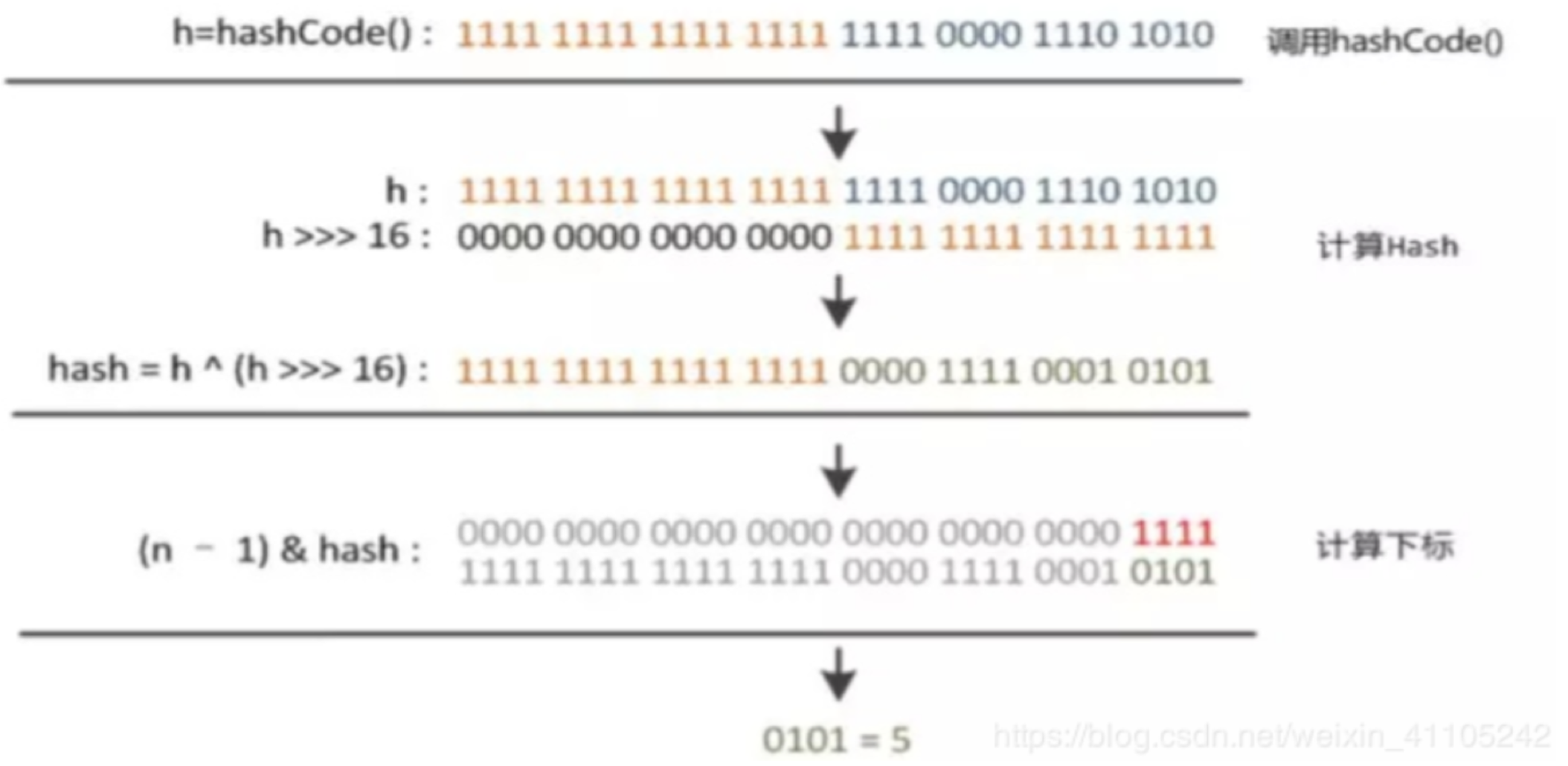HashMap源码分析——put方法
static final int hash(Object key) { int h; return (key == null) ? 0 : (h = key.hashCode()) ^ (h >>> 16); //将h无符号右移16为相当于将高区16位移动到了低区的16位,
//再与原hashcode做异或运算,
// 可以将高低位二进制特征混合起来 }
hashCode方法返回的类型是int,默认是对象的内存地址 , 占内存 32 byte 。
注:为什么使用异或运算:
异或运算能更好的保留各部分的特征,如果采用&运算计算出来的值会向0靠拢,采用|运算计算出来的值会向1靠拢
以上代码是put方法中进行调用,用来执行哈希操作的 ,具体细节如下图:

public V put(K key, V value) { return putVal(hash(key), key, value, false, true); }
执行完hash操作后,会产生一个哈希值,然后调用 putVal方法完成具体的put操作。在分putVal方法之前,先来分析下resize()扩容方法
在分析一个方法的源码之前,或者要加深对一个方法的了解,最好是从整体上能知道这个方法完成了什么,这样再细看源码时才有助于思路清晰,那么这个resize方法究意做了什么呢?
最直接了当的方式当然是看注释:
Initializes or doubles table size. // 初始化数组大小或对数据进行加倍的扩容
If null, allocates in accord with initial capacity target held in field threshold. //如果数组是null,就按 类的成员变量threshold的值进行容量的初始分配。
Otherwise, because we are using power-of-two expansion, // 否则以2的冥次方形式进行扩容
the elements from each bin must either stay at same index, //扩容后数组中每个桶中的元素还需要保存在新数据的同样的桶中。
or move with a power of two offset in the new table. //或者在新表中以二次方偏移量整体移动到新的索引下
final Node<K,V>[] resize() { Node<K,V>[] oldTab = table; int oldCap = (oldTab == null) ? 0 : oldTab.length; // 获取原数组(后面称桶)的容量 int oldThr = threshold; //threshold初始值为0 , threshold表示当HashMap的size大于threshold时会执行resize操作 int newCap, newThr = 0; if (oldCap > 0) { if (oldCap >= MAXIMUM_CAPACITY) { //检查容量是否超过最大值 threshold = Integer.MAX_VALUE; return oldTab; } else if ((newCap = oldCap << 1) < MAXIMUM_CAPACITY && oldCap >= DEFAULT_INITIAL_CAPACITY) newThr = oldThr << 1; // double threshold //如果容量的阈值大于默认的初始值16且小于最大值,则左移一位即乘2进行扩容 } else if (oldThr > 0) // initial capacity was placed in threshold newCap = oldThr; //如果阈值初始就大于0,则直接使用,一般是通过有参构造方法设置的 else { // zero initial threshold signifies using defaults newCap = DEFAULT_INITIAL_CAPACITY; //这种情况表示是用无参构造产生hashmap对象的,阈值初始为0,则设置容量为默认的16,阈值为12 newThr = (int)(DEFAULT_LOAD_FACTOR * DEFAULT_INITIAL_CAPACITY); } if (newThr == 0) { //当只满足老阈值大于0的条件时,新阈值等于新容量*默认扩容因子 float ft = (float)newCap * loadFactor; newThr = (newCap < MAXIMUM_CAPACITY && ft < (float)MAXIMUM_CAPACITY ? (int)ft : Integer.MAX_VALUE); } threshold = newThr; @SuppressWarnings({"rawtypes","unchecked"}) Node<K,V>[] newTab = (Node<K,V>[])new Node[newCap]; table = newTab; //创建产生新的桶 if (oldTab != null) { //如果老数组不为空,那么涉及到元素的转移操作 for (int j = 0; j < oldCap; ++j) { Node<K,V> e; if ((e = oldTab[j]) != null) { //先将桶中的元素赋值给e oldTab[j] = null; //将桶中的数据置为null if (e.next == null). newTab[e.hash & (newCap - 1)] = e; //如果桶中没有链表则直接将值赋给新的桶 else if (e instanceof TreeNode) //如果是红黑树的处理 ((TreeNode<K,V>)e).split(this, newTab, j, oldCap); else { // preserve order //如果是链表的处理 Node<K,V> loHead = null, loTail = null; Node<K,V> hiHead = null, hiTail = null; Node<K,V> next; do { next = e.next; if ((e.hash & oldCap) == 0) { if (loTail == null) loHead = e; else loTail.next = e; loTail = e; } else { if (hiTail == null) hiHead = e; else hiTail.next = e; hiTail = e; } } while ((e = next) != null); if (loTail != null) { loTail.next = null; newTab[j] = loHead; } if (hiTail != null) { hiTail.next = null; newTab[j + oldCap] = hiHead; } } } } } return newTab; }
下面详细分析putVal方法:
1 final V putVal(int hash, K key, V value, boolean onlyIfAbsent, // 参数说明 2 boolean evict) { 3 Node<K,V>[] tab; Node<K,V> p; int n, i; 4 if ((tab = table) == null || (n = tab.length) == 0) // table为HashMap定义的成员变量 , 如果table为null或者数组长度为0则进行扩容 5 n = (tab = resize()).length; // resize()扩容方法,n保存扩容后的长度 6 if ((p = tab[i = (n - 1) & hash]) == null) // i = (n - 1) & hash 确定要保存存的节点的数组索引的位置 ,并且p设置为该索引处的指针 7 tab[i] = newNode(hash, key, value, null); //如果当前索引位置元素为null,则在此保存要put的元素 8 else { //表示索引处之前已有元素 9 Node<K,V> e; K k; 10 if (p.hash == hash && //如果要put的元素的hash值与已存在元素的hash值相同 11 ((k = p.key) == key || (key != null && key.equals(k)))) // (k = p.key) == key判断是不是同一个对象 或者 key不为null且key的值相等 12 e = p; // 表示在数组上找到与put的key相匹配的元素,并将该元素赋给e 13 else if (p instanceof TreeNode) // 如果如果桶上面是个TreeNode,那需要在树上进入插入 14 e = ((TreeNode<K,V>)p).putTreeVal(this, tab, hash, key, value); 15 else { //否则在链表上进行插入 16 for (int binCount = 0; ; ++binCount) { 17 if ((e = p.next) == null) { 18 p.next = newNode(hash, key, value, null); 19 if (binCount >= TREEIFY_THRESHOLD - 1) // -1 for 1st 20 treeifyBin(tab, hash); 21 break; 22 } 23 if (e.hash == hash && 24 ((k = e.key) == key || (key != null && key.equals(k)))) 25 break; 26 p = e; 27 } 28 } 29 if (e != null) { // existing mapping for key. 在树上或链表上找到了key相同的节点 30 V oldValue = e.value; 31 if (!onlyIfAbsent || oldValue == null) 32 e.value = value; 33 afterNodeAccess(e); 34 return oldValue; 35 } 36 } 37 ++modCount; 38 if (++size > threshold) 39 resize(); 40 afterNodeInsertion(evict); 41 return null; 42 }



